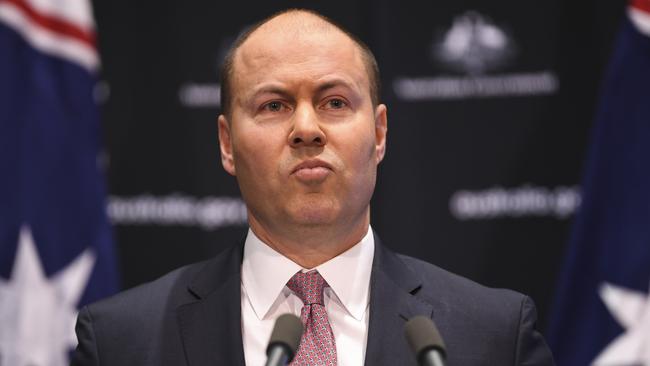Coronavirus: Biggest household spending drop in 34 years
National accounts figures reveal the steepest drop in household spending in 34 years.

The steepest drop in household spending in 34 years drove Australia’s first quarterly economic contraction since 2011, national accounts figures reveal.
Consumption fell 1.1 per cent as Australians observed social distancing restrictions and were unable to attend cinemas and some shops and cafes throughout March, resulting in a 0.6-percentage-point drag on gross domestic product over the quarter.
Australians spent 2.4 per cent less on services, overwhelming a 1 per cent increase in spending on goods as shoppers in March flocked to the supermarket to stock up on essentials as the coronavirus restrictions began to bite.
Josh Frydenberg said the first quarterly economic contraction since 2011 was “really a consumption story … This is the economic consequences of the health decisions that we’ve had to take (and) consumption will pick up as the restrictions are eased.”
Spending on transport services collapsed by 12 per cent — the largest fall on record — while hotel bookings and cafe and restaurant visits were down by 9.2 per cent, the latest Australian Bureau of Statistics show.
By comparison, spending on food boomed by 5.7 per cent over the quarter, against historical increases in the order of less than 0.5 per cent in previous periods.
Bottle shops enjoyed a 3.5 per cent increase over the quarter. Spending on items considered less essential, such as clothing and footwear, plummeted 8.9 per cent.
Consumption for the 12 months to the end of March was 0.2 per cent lower, the same decline as during the global financial crisis.
However, economists are hopeful that a higher rate of savings — the household savings rate lifted to 5.5 per cent from 3.5 per cent in the December quarter — will mean more money will be spent later in the year. “What’s clear is that households already began tightening before the income and jobs shock had really taken hold, and also before government support had hit full stride,” JPMorgan economist Ben Jarman said.
Mr Jarman said the $1500-a-fortnight JobKeeper wage subsidy program and boosted JobSeeker payments would “boost the savings rate to double figures” in the June quarter.
The fall in spending for the first three months of the year was in part due to bushfires and smoke haze, which, the ABS said, had “led to disruptions to domestic travel and reduced retail foot traffic”.
“This was followed by escalating concerns about the spread of COVID-19 that led to restrictions on overseas travel, bans on indoor and outdoor gatherings and domestic travel, increased work and leisure from home, and limits on business trading,” they wrote.
The Treasurer on Wednesday said he was hopeful consumption would recover in line with a steady improvement in consumer sentiment since the depths of March, but economists flagged that the June quarter national accounts would bear the brunt of the collapse in spending.
Citi predicts consumption will drop by 13 per cent in that period, driving a 6 per cent GDP plunge — markedly better than Treasury’s early estimates for a 10 per cent fall, but nonetheless a contraction of historical proportions.
More recent ANZ card spending data suggests Australians have become more comfortable opening their wallets as the social distancing measures are lifted.



